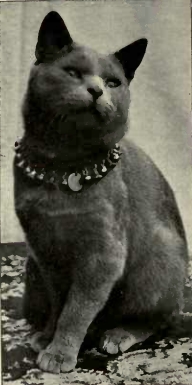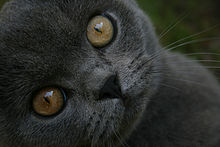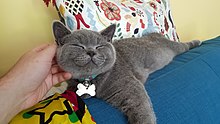British Shorthair
| British Shorthair | |
|---|---|
 British Shorthair in the classic colour ’blue’. | |
| Other names | British Blue (legacy) |
| Origin | |
| Breed standards | |
| CFA | standard |
| FIFe | standard |
| TICA | standard |
| WCF | standard |
| FFE | standard |
| ACF | standard |
| ACFA/CAA | standard |
| CCA-AFC | standard |
| GCCF | standard |
| Domestic cat (Felis catus) | |
The British Shorthair is the pedigreed version of the traditional British domestic cat, with a distinctively stocky body, thick coat, and broad face. The most familiar colour variant is the "British Blue", with a solid grey-blue coat, pineapple eyes, and a medium-sized tail. The breed has also been developed in a wide range of other colours and patterns, including tabby and colourpoint.
It is one of the most ancient cat breeds known. In modern times, it remains the most popular pedigreed breed in its native country, as registered by the UK's Governing Council of the Cat Fancy (GCCF). A quarter of all kittens registered with the GCCF each year are British Shorthairs, making the British the most popular pedigree cat in the UK.[1]
The breed's good-natured appearance and relatively calm temperament make it a frequent media star, notably as the inspiration for John Tenniel's famous illustration of the Cheshire Cat from Alice in Wonderland. The Cat Fanciers' Association profile reads: "When gracelessness is observed, the British Shorthair is duly embarrassed, quickly recovering with a 'Cheshire cat smile'."[2]
History
The origins of the British Shorthair most likely date back to the first century AD, making it one of the most ancient identifiable cat breeds in the world.[citation needed] These cats were imported by the Romans who kept them to keep the camps clear of snakes, mice and insects.
These cats then interbred with the local European wildcat population. Over the centuries, their naturally isolated descendants developed into distinctively large, robust cats with a short but very thick coat, to better withstand conditions on their native islands. Based on artists' representations, the modern British Shorthair is unchanged from this initial type.[3]

Selective breeding of the best examples of the type began in the nineteenth century, with emphasis on developing the unusual blue-grey variant called the "British Blue" or "English type" (to distinguish it from the more fine-boned "Russian type"). Some sources directly credit UK artist, and pioneering cat fancier, Harrison Weir with the initial concept of standardising the breed. Others suggest a group of breeders may have been involved. The new British Shorthair was featured at the first-ever cat show, organised by Weir and held at the Crystal Palace in London in 1871, and enjoyed great initial popularity.[4]
By the 1900s with the advent of the newly imported Persian and other long-haired breeds, the British Shorthair had fallen out of favour, and breeding stock had become critically rare by World War I.[5] At least partially to alleviate this, British Shorthair breeders mixed Persians into their bloodlines.[6] The genes thus introduced would eventually become the basis for the British Longhair. At the time, any long-haired cats produced were placed into the Persian breeding program.[7] As all cats with the blue colouration were then judged together as variants on a de facto single breed. The Blue Shorthair, outcrossings of the British with the Russian Blue were also common.[3]

After the war, in an attempt to maintain the breed standard, the GCCF decided to accept only third-generation Persian/British Shorthair crosses.[citation needed] This contributed to another shortage of pure breeding stock by World War II, at which point the Persian and Russian Blue were reintroduced into the mix.[citation needed] British Shorthair breeders also worked with the French Chartreux, another ancient breed, which although genetically unrelated to the British Blue, is a very similar cat in appearance. Breeders worked to re-establish the true British type, and by the late 1970s, the distinctive British Shorthair had achieved formal recognition from both the Cat Fanciers' Association (CFA) and The International Cat Association (TICA).[3] According to the GCCF's 2013 registry data, it is once again the most popular pedigreed breed in its native country.[8]
Description
Appearance


The British Shorthair is a relatively powerful-looking large cat, having a broad chest, strong thick-set legs with rounded paws and a medium-length, blunt-tipped tail. The head is relatively large and rounded, with a short muzzle, broad cheeks (most noticeable in mature males, who tend to develop prominent jowls) and large round eyes that are deep copper orange in the British Blue and otherwise vary in colour depending on the coat. Their large ears are broad and widely set.[9]
The British Blue variant can often be confused with the grey Scottish Fold, a breed closely related to the British Shorthair. However, the Shorthair can be characterised by having its pointy triangular ears, whereas the Fold has softer, folded ears.
They are slow to mature in comparison with most cat breeds, reaching full physical development at approximately three years of age. Unusually among domestic cats they are a noticeably sexually dimorphic breed, with males averaging 9–17 lb (4.1–7.7 kg) and females 7–12 lb (3.2–5.4 kg).[10][11]
Coat, colour, and patterns
The British Shorthair's coat is one of the breed's defining features. It is very dense, but does not have an undercoat; thus, the texture is plush rather than woolly or fluffy, with a firm, "crisp" pile that breaks noticeably over the cat's body as it moves.[3][9]
Although the British Blue remains the most familiar variant, British Shorthairs have been developed in many other colours and patterns. Black, blue, white, red, cream, silver, golden and—most recently—cinnamon and fawn are accepted by all official standards, either solid or in colourpoint, tabby, shaded and bicolour patterns; the GCCF, FIFe and TICA also accept chocolate and its dilute lilac, disallowed in the CFA standard.[12] All colours and patterns also have tortoiseshell variants.[9]
The Tabby patterns include:[13] Classic Tabby, Mackerel Tabby, Spotted & Ticked Tabby. The non-tabby patterns include: Tortoiseshell, Bi-Colour, Van patterns Bi-Colour & White, Smoke, Tipped & Colourpointed.
British Shorthair's nose colour: black, cherry red, brick red; a circle of black nasal line on the periphery.
-
2-month-old female blue and white hawksbill British shorthair kitten
-
4-month-old golden shaded male kitten
-
5-month-old lilac female kitten
-
6-month-old silver classic tabby male kitten
-
8-month-old British shorthair in silver coat octa
-
1-year-old male British shorthair kitten in pure white
-
Blue bicolour adult male
Temperament

British Shorthairs are an easygoing and dignified breed, not as active and playful as many, but sweet-natured and devoted to their owners, making them a favorite of animal trainers. They tend to be safe around other pets and children since they will tolerate a fair amount of physical interaction, but as a rule do not like to be picked up or carried. They require only minimal grooming and take well to being kept as indoor-only cats; however, they can be prone to obesity unless care is taken with their diet.[3][10]
British Shorthairs are quiet and vigilant, but if they trust their owners, they will silently follow their activities and stay with them. British Shorthair cats are not lap cats. They are more accustomed to staying beside people than squatting on people's laps. Similarly, they prefer the feeling of having their feet on the ground. They have a low voice and a moderate activity level. When no one is at home, they will stay at home quietly and wait for their owners to return.[14][15]
Cat Shows
First introduced to Britain by the Romans, the British shorthair was one of the domestic cat breeds originally bred for its hunting prowess. In the last 150 years, the breed pivoted towards being bred for physical qualities.[16] The British Shorthair breed debut --- along with a wide range of other selectively bred felines --- in the first organized cat show arranged by Harrison Weir at London's Crystal Palace in 1871.[17] Ever since their debut, British shorthairs maintained the premiere pedigree at cat shows, up until 1895.[18]
Shortly after the British Shorthair exhibit in the Crystal Palace show, the popularity of British Shorthair increased. The public began searching for breeders of British Shorthairs with various character and color traits, all in the pursuit of "exoticness".[19] From the late 1800's up to the early 1910's, certain British Shorthairs would occasionally earn notoriety, or decorated titles in Cat Competitions.[20] The British Shorthair publicity from 19th and 20th century cat shows helped British Shorthairs become one of the most popular pet cat breeds today. For example, in the 1980's, the British Shorthair was featured in competition by the CFA, or Cat Fancier’s Association, which led to an increase in demand for British Shorthairs as household pets. As of 2023, the British Shorthair ranks the 6th most popular cat breed in the United States.[21]

As of 2015,[update] the TICA cat show competition standards for British Shorthairs judge the cats for their circular head shape, muzzle, and cheeks. Small to medium ears are desired, with large, round, leveled eyes. Eye shape is more important than color. The muzzle and chin shape should complement the circular face; the profile and nose should be short, further complementing the circular face. The neck should give the illusion of the cat having no neck, blending in with the cheeks. The body of the cat should have a sturdy and muscular torso, complemented by medium to short legs, finished with round medium to large feet. The tail of the cat should be thick at the base, and tapers to a rounded tip, totaling about two thirds of the body’s length. Internally, the cat should have substantial boning, and a firm and sturdy musculature. As for the cat’s coat, no preference on color is stated, rather the coat should be straight, dense, and even in length.[22]
Health
The UK breed committee considers the British Shorthair a long-lived cat, with a life expectancy of 14–20 years.[12] Vet clinic data from England shows a median lifespan of 11.8 years.[23] Swedish insurance data puts the median lifespan of the breed at > 12.5 years. 82% of British Shorthairs lived to 10 years or more and 54% lived to 12.5 years or more.[24]
Hypertrophic cardiomyopathy (HCM) can be a problem in the breed. A Danish prevalence study with more than 329 cats showed that 20.4% of males and 2.1% of the females had HCM. On top of this 6.4% of males and 3.5% of females were judged to be equivocal.[25] HCM testing of males used for breeding is now mandatory for breeders organised under the Danish Fife member, Felis Danica.[26]
The breed is thought to be at high risk of polycystic kidney disease (PKD).[27] A DNA test lab has noted a significant decrease of the PKD mutations in tested populations. Carrier frequency is now at 1%.[28]
Potential health problems
This disease forms a cyst in the cat's kidney, causing organ failure.[29] Polycystic kidney disease can be detected through genetic testing or ultrasound. There is no cure for polycystic kidney disease but there are drugs that can alleviate the effects and its advancement.
The heart muscle thickens which limits the amount of blood that is pumped, leading to blood clots and heart failure.[29] Cardiomyopathy can be detected through ultrasound, ECG, and x-ray. Drugs can alleviate and slow down the advancement of the disease.
And urinary tract diseases are very common.
Hyperthyroidism
Some British Shorthairs have hyperthyroidism, which is caused by excessive thyroid hormone production, affecting metabolism. It brings serious problems to cats because thyroid hormone affects nearly all of cats' organs, especially their hearts.[30][31] Older cats, in general, are more susceptible to it. Some of the signs are weight loss, panting, sickness, and greasy coat. Cats with hyperthyroidism need surgery and medication as treatment.[32]
Cystitis
Cystitis affects cats' urinary tracts and leads to inflammation in their urinary bladders. Cystitis is hard to cure.[33][34] Stress, bacterial infection, and bladder stones usually cause cystitis. Some of the symptoms are frequent urination and having blood in cats' urine. Cats with cystitis need plenty of water and special medical diet. The treatments include anti-inflammatory medication and antibiotics.[35][36]
Commemoration
In 2022, the British Shorthair was one of eight cats featured on a series of UK postage stamps issued by the Royal Mail.[37]
References
- ^ "GCCF Online > Cat Breeds > British Shorthair". gccfcats.org. Retrieved 14 November 2020.[permanent dead link]
- ^ Geyer, Georgie Anne. When Cats Reigned Like Kings: On the Trail of the Sacred Cats. Transaction Publishers. p. 219.
- ^ a b c d e "British Shorthair". The International Cat Association. Archived from the original on 31 October 2017. Retrieved 26 July 2014.
- ^ "British Shorthair Cats | British Shorthair Cat Breed Info & Pictures | petMD". petmd.com. Retrieved 12 April 2017.
- ^ "GCCF Online > Home". gccfcats.org. Retrieved 2 May 2021.
- ^ Cat, My British Shorthair (28 January 2019). "British Shorthair Or Persian Cat?". My British Shorthair. Retrieved 2 May 2021.
- ^ "British Longhair Mixed Cat Breed Pictures, Characteristics, & Facts". CatTime. 17 June 2014. Retrieved 2 May 2021.
- ^ "GCCF: Registry data analysis 2013" (PDF). gccfcats.org. Governing Council of the Cat Fancy (UK). Archived from the original (PDF) on 28 July 2014. Retrieved 27 July 2014.
- ^ a b c "British Shorthair Breed Standard" (PDF). cfainc.org. Cat Fanciers' Association. Archived (PDF) from the original on 20 June 2023. Retrieved 4 July 2023.
- ^ a b "CFA: Introduction to the British Shorthair". cfainc.org. Archived from the original on 25 June 2014. Retrieved 27 July 2014.
- ^ "The International Cat Association – British Shorthair".
- ^ a b "Breeding Policy For The British Shorthair" (PDF). gccfcats.org. British Shorthair Breed Advisory Committee. 12 September 2012. Archived (PDF) from the original on 18 May 2023. Retrieved 27 July 2014.
- ^ "British Shorthair General Type Standard" (PDF). Gccfcats.org. 2018. Archived from the original (PDF) on 16 May 2021. Retrieved 2 August 2018.
- ^ "British Shorthair". Petfinder. Retrieved 27 April 2021.
- ^ "British Shorthair Breed". tica.org (in Chinese (China)). 13 August 2018. Retrieved 27 April 2021.
- ^ "Introducing the Cat", The Cat, Princeton University Press, pp. 6–12, 2020-12-31, retrieved 2023-10-10
- ^ Driscoll, Carlos A.; Clutton-Brock, Juliet; Kitchener, Andrew C.; O’Brien, Stephen J. (2009). "The Taming of the Cat". Scientific American. 300 (6): 68–75. ISSN 0036-8733.
- ^ Simpson, Frances (1903). The book of the cat. University of California Libraries. London, Paris, New York, Melbourne, Cassell and company, limited.
- ^ "The History Project: English (British) Shorthair". cat-o-pedia.org. Retrieved 2023-10-10.
- ^ "The History Project: English (British) Shorthair". cat-o-pedia.org. Retrieved 2023-10-10.
- ^ "Top 20 Most Popular Cat Breeds – Forbes Advisor". forbes.com. Retrieved 2023-10-10.
- ^ https://www.tica.org/phocadownload/bs.pdf.
{{cite web}}: Missing or empty|title=(help) - ^ O'Neill, D. G. (2014). "Longevity and mortality of cats attending primary care veterinary practices in England" (PDF). Journal of Feline Medicine and Surgery. 17 (2): 125–33. doi:10.1177/1098612X14536176. PMID 24925771. S2CID 7098747. "n=69, median=11.8, IQR 5.8-16.3, range 0.0-21.0"
- ^ Egenvall, A.; Nødtvedt, A.; Häggström, J.; Ström Holst, B.; Möller, L.; Bonnett, B. N. (2009). "Mortality of Life-Insured Swedish Cats during 1999–2006: Age, Breed, Sex, and Diagnosis". Journal of Veterinary Internal Medicine. 23 (6): 1175–1183. doi:10.1111/j.1939-1676.2009.0396.x. PMC 7167180. PMID 19780926.
- ^ Granström, S.; Nyberg Godiksen, M. T.; Christiansen, M.; Pipper, C. B.; Willesen, J. T.; Koch, J. (2011). "Prevalence of Hypertrophic Cardiomyopathy in a Cohort of British Shorthair Cats in Denmark". Journal of Veterinary Internal Medicine. 25 (4): 866–871. doi:10.1111/j.1939-1676.2011.0751.x. PMID 21736622.
- ^ "Felis Danica". Felisdanica.dk. Retrieved 29 June 2014.
- ^ "Polycystic kidney disease (PKD): Gene test and negative register". International Cat Care. Archived from the original on 2 November 2014. Retrieved 2 November 2014.
- ^ "PKD – Polycystic Kidney Disease – British Shorthair". Antagene. Archived from the original on 17 August 2018. Retrieved 2 November 2014.
- ^ a b "What to know if you're buying a… British Shorthair cat". petplan.co.uk. Retrieved 12 October 2020.
- ^ "Cat Hyperthyroidism (Overactive Thyroid) Symptoms and Treatments". WebMD. Retrieved 29 April 2021.
- ^ "Hyperthyroidism in Cats". Cornell University College of Veterinary Medicine. 11 October 2017. Retrieved 29 April 2021.
- ^ "British Shorthair breed & health info". everypaw.com. Retrieved 22 April 2021.
- ^ "Cystitis in cats". battersea.org.uk. 17 December 2019. Retrieved 29 April 2021.
- ^ "Cystitis and Lower Urinary Tract Disease in Cats". vca_corporate. Retrieved 29 April 2021.
- ^ "British Shorthair Personality, Temperament and Lifespan". petplan.co.uk. Retrieved 22 April 2021.
- ^ "British Shorthair breed & health info". everypaw.com. Retrieved 22 April 2021.
- ^ "Royal Mail releases new cat-themed stamp collection". Telegraph and Argus. Retrieved 23 September 2022.







